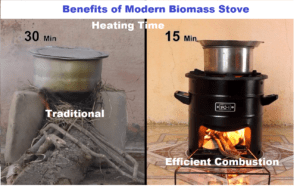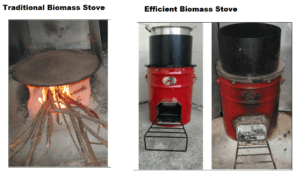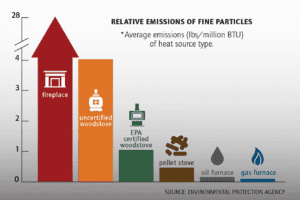How Does a Biomass Gas Stove Work?
- Biomass stoves create heat by burning compressed wood or biomass pellets to create
- By slowly feeding fuel automatically from the storage container (called the hopper) into the burn tray
- A stable flame is created and monitored to ensure maximum efficiency.
- When burned, the energy in biomass is released as heat
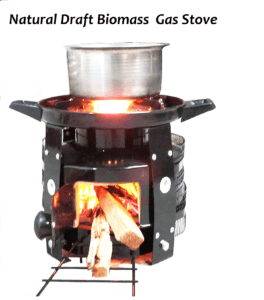
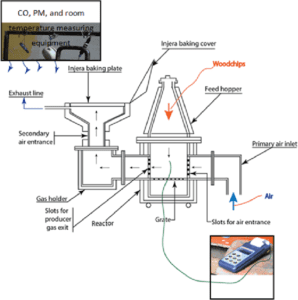
Heating Value of Biomass for Cost Determination
- The heating value of biomass wood, pellets, and briquettes can vary depending on the type of biomass material used, its moisture content, and the density of the final product.
- Heating value is typically measured in terms of energy content, usually expressed in units like kilocalories per kilogram (kcal/kg) or megajoules per kilogram (MJ/kg).
- Here are approximate heating values for common types of biomass pellets and briquettes:
Biomass Pellets:
- Wood Pellets:
- Wood pellets are one of the most common types of biomass pellets.
- They are made from compressed sawdust, wood chips, and other wood residues.
- The heating value of wood pellets is typically in the range of 4,000 to 4,800 kcal/kg (16.7 to 20.1 MJ/kg),
- The heating value depends on the wood species and processing methods.
- Agricultural Crop Residue Pellets:
- Pellets made from agricultural residues like straw, rice husks, and corn stalks
- The heating values of such pellets range from 3,000 to 4,500 kcal/kg (12.5 to 18.8 MJ/kg).
- These values can vary based on the type of crop residue and its composition.
- Miscanthus Pellets:
- Miscanthus, a perennial grass, can be pelletized for use as a biomass fuel.
- Miscanthus pellets can have a heating value of around 3,800 to 4,500 kcal/kg (15.9 to 18.8 MJ/kg).

Biomass Briquettes:
- Wood Briquettes:
- Like wood pellets, wood briquettes are made from sawdust, wood chips, and other wood residues.
- The heating value of wood briquettes is typically similar to that of wood pellets, ranging from 4,000 to 4,800 kcal/kg (16.7 to 20.1 MJ/kg).
- Agricultural Crop Residue Briquettes:
- Briquettes made from agricultural residues can have heating values similar to their pellet counterparts,
- It ranges from 3,000 to 4,500 kcal/kg (12.5 to 18.8 MJ/kg).
- Charcoal Briquettes:
- Charcoal briquettes are made from charcoal powder and a binder.
- They have a higher heating value compared to biomass-based briquettes due to their high carbon content.
- Charcoal briquettes can have a heating value of around 7,000 to 8,000 kcal/kg (29.3 to 33.5 MJ/kg).
- It’s important to note that the heating value can be influenced by factors such as moisture content, density, and the specific composition of the biomass material.
- Proper storage and handling are also crucial to maintaining the fuel’s quality and energy content.
- Additionally, these values are approximate and can vary based on the specific production methods and characteristics of the biomass pellets or briquettes.
- The comparison of biomass pellets and briquettes is given in the post.
Types of Biomass Stove
- There are several types of biomass stoves designed to efficiently burn biomass materials for cooking and heating purposes.
- These are just a few examples of the various types of biomass stoves available.
- Each type has its own advantages and considerations, and the choice of the stove should be based on factors such as the local biomass resources, cooking habits, cultural preferences, and available technology.
- These stoves vary in terms of design, efficiency, fuel compatibility, and intended use.
- Here are some common types of biomass stoves:
Cookstoves
- Cookstoves are designed specifically for cooking purposes.
- They come in various sizes and designs to accommodate different cooking needs, from small household cooking to larger community cooking.
- Cookstoves can use a variety of biomass fuels, including wood, agricultural residues, and even dried dung.
Rocket Stoves:
- Rocket stoves are efficient and clean-burning stoves known for their design that promotes a strong and focused airflow, improving combustion.
- They typically have a vertical combustion chamber with an insulated chimney that directs the smoke away from the cooking area.
- Rocket stoves are designed to maximize heat transfer to the cooking vessel and reduce fuel consumption.

Gasifier Stoves
- Gasifier stoves convert solid biomass into combustible gases (syngas) through a controlled combustion process.
- These gases are then burned with a clean flame, resulting in efficient combustion and reduced emissions.
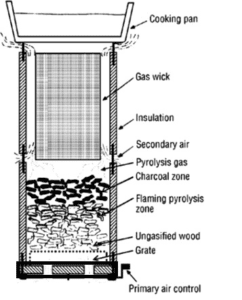
- Gasifier stoves are known for their high thermal efficiency and cleaner burning compared to traditional stoves.
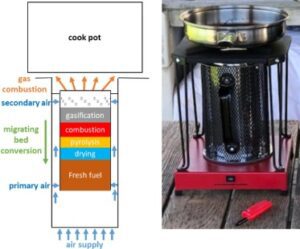
Biomass Pellet Stoves:
- These stoves are designed to burn compressed biomass pellets, which are manufactured from various biomass materials.
- Pellet stoves are automated and often used for space heating as well as cooking. They offer consistent heat output and can be more convenient than traditional cookstoves.

Biomass Briquette Stove
- Biomass briquette stoves are a type of cooking technology that utilizes biomass briquettes as fuel for cooking and heating purposes as mentioned in the post.
- Biomass briquettes are compressed blocks of biomass materials, such as agricultural residues, wood chips, sawdust, and other organic waste. The waste organic materials can be used for making biomass pellet or briquettes as presented in the post.

- These stoves are designed to burn these briquettes efficiently, providing a cleaner and more sustainable alternative to traditional cooking methods

TLUD (Top-Lit Updraft) Stoves:
- TLUD stoves are designed to be loaded from the top with biomass fuel.
- They work by allowing the fuel to pyrolyze (decompose in the absence of oxygen) from the top down, with the generated gases being burned as they rise through the combustion chamber.
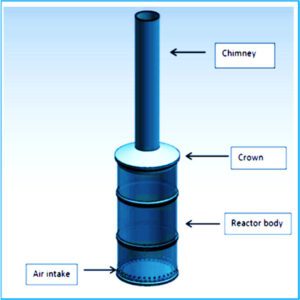
- TLUD stoves are known for their efficient combustion and low emissions.

Anila Stoves:
- These stoves are an Indian innovation that uses a combination of a biomass gasifier and a heat exchanger to generate heat for cooking.
- The stoves are designed to produce a clean and consistent flame, reducing indoor air pollution and fuel consumption.
Fan-Assisted Stoves:
- These stoves incorporate a fan to control the airflow, improving combustion efficiency.
- The fan can help maintain a more consistent flame and increase the rate of combustion, resulting in cleaner burning and reduced fuel consumption.

Community Biomass Stoves
- These larger stoves are designed to serve entire communities or institutions, such as schools or health centers. They are capable of cooking larger quantities of food and often use innovative designs to optimize combustion efficiency.
- Portable Biomass Stoves: These stoves are designed for outdoor and camping use. They are lightweight, compact, and often foldable, making them convenient for travel. Portable biomass stoves can use a variety of biomass fuels, making them versatile for different environments.
- Improved Mud Stoves: These stoves are an upgrade over traditional mud stoves commonly used in rural areas. They incorporate design improvements to enhance combustion efficiency and reduce smoke emissions.
How cheaper the biomass cooking on pellet or is cheaper than natural gas?
- If you think of the more economical type of stove to run, a pellet stove is going to easily win
- Biomass or pellets are relatively cheap and even with the electrical cost of running the blowers, biomass gas cooking is much lower than a gas stove
Can biogas replace LPG in future?
- Those countries can not afford natural gas like LPG, so they have been using biomass gas
- In rural areas, storage, and transportation of petroleum gases are difficult. In such areas, biomass is easily available to create energy by combustion
- Providing thermal energy, biogas can also be used for cooking, and replacing LPG.
- The cost of LPG gas cylinders is increasing, all rural people can not buy gas to burning
Which Biomass Gas Stove is better?
- Natural draft vertical Biomass Stove

- Low-cost Natural Draft Biomass Stove

Scope of Biomass stove in India
Biomass stoves have significant potential and a relevant scope for rural areas in India. These areas often lack access to clean and efficient cooking technologies, leading to indoor air pollution, health issues, and environmental degradation. Biomass stoves offer a solution to these problems by providing a more sustainable and cleaner way of cooking. Here are some key points regarding the scope of biomass stoves in India’s rural areas:
Addressing Health and Environmental Issues:
- Traditional cooking methods like open fires and rudimentary stoves that burn wood, crop residues, and other biomass materials release harmful indoor air pollutants, leading to respiratory diseases and other health issues.
- Biomass stoves can help reduce indoor air pollution and its associated health risks.
Energy Access
- Many rural areas in India still lack access to modern energy sources.
- Biomass stoves can utilize locally available biomass resources, making energy access more feasible and affordable for rural households.
Sustainable Resource Use:
- By using agricultural residues and other organic materials as fuel, biomass stoves contribute to the sustainable management of biomass resources.
- This helps in reducing deforestation and overexploitation of forests for fuelwood.
Reduced Deforestation:
- Traditional cooking methods often require significant amounts of firewood, leading to deforestation and environmental degradation.
- Biomass stoves can reduce the demand for firewood, thus contributing to forest conservation efforts.
Income Generation
- In rural areas, communities can potentially engage in the production of biomass pellets or briquettes as a fuel source for the stoves.
- This could create local economic opportunities and contribute to livelihood enhancement.
Carbon Emission Reduction:
- While biomass stoves still emit carbon dioxide when burning biomass materials, they are generally more efficient than traditional methods, leading to lower overall emissions. They can be designed to optimize combustion and reduce emissions.
Technology Advancements:
- There have been continuous advancements in biomass stove technology, leading to more efficient and cleaner-burning designs.
- Improved combustion and heat transfer efficiency can further reduce fuel consumption and pollution.
Behavioral Change and Adoption:
- However, the successful implementation of biomass stoves requires addressing behavioral and cultural factors.
- People in rural areas are often accustomed to traditional cooking practices, so effective awareness campaigns and community engagement are necessary to promote the adoption of cleaner cooking technologies.
Government Initiatives and Policies:
- The Indian government has been promoting the adoption of clean cooking solutions through various schemes and initiatives.
- These efforts can contribute to the widespread adoption of biomass stoves in rural areas.
Challenges:
- Challenges include the affordability of quality stoves, fuel availability, maintenance, and ensuring sustained usage over time. Moreover, the design of the stove must be appropriate for the specific cooking practices and cultural preferences of the community.
What are the health risks of Biomass cooking?
- Indoor air pollution (IAP) is caused by the burning of solid fuel (wood, charcoal, coal, dung, and crop residues) and it results in various types of emissions
- Major emissions are Carbon monoxide (CO), and particular matter
- For safety PM2.5 (fine particular matter with aerodynamic diameter ≤2.5 μm) are major emission associated with the IAP
- Health risks for high emissions can cause increased chronic diseases such as blood pressure or hypertension, low birth weight, cardiovascular diseases, lung cancer, mutagenicity, and other kinds of neoplasia.

Summary
- In conclusion, the scope of biomass stoves in India’s rural areas is substantial, offering a means to address health issues, improve energy access, promote sustainable resource use, and mitigate environmental impacts.
- However, successful implementation requires a holistic approach that considers technological, behavioral, economic, and policy aspects.
Reference
- R. Sharler, G. Archan, L.V. Berg, D. Lello, C. Hachenour, A. Couce, Rakos, Emission Minimization with a top-lit updraft gasifier based on the experiments and CFD Analysis, Energy conv. Mag (2021)
- Use of TLUD biomass stove in Uganda



